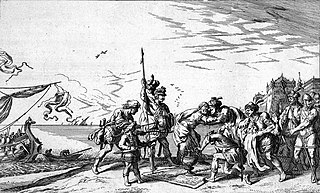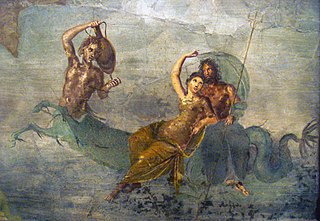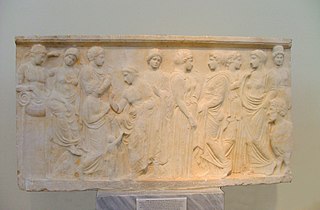
In Greek mythology, Daedalus was a skillful architect and craftsman, seen as a symbol of wisdom, knowledge and power. He is the father of Icarus, the uncle of Perdix, and possibly also the father of Iapyx. Among his most famous creations are the wooden cow for Pasiphaë, the Labyrinth for King Minos of Crete which imprisoned the Minotaur, and wings that he and his son Icarus used to escape Crete. It was during this escape that Icarus did not heed his father's warnings and flew too close to the sun; the wax holding his wings together melted and Icarus fell to his death.

In Greek mythology, Anius was a king of Delos and priest of Apollo.

In Greek mythology, Peneus was a Thessalian river god, one of the three thousand Rivers (Potamoi), a child of Oceanus and Tethys.

In Greek mythology, Deucalion was the son of Prometheus; ancient sources name his mother as Clymene, Hesione, or Pronoia. He is closely connected with the flood myth in Greek mythology.

Dīs Pater, otherwise known as Rex Infernus or Pluto, is a Roman god of the underworld. Dis was originally associated with fertile agricultural land and mineral wealth, and since those minerals came from underground, he was later equated with the chthonic deities Pluto (Hades) and Orcus.
Levana is an ancient Roman goddess involved in rituals pertaining to childbirth. Augustine says that dea Levana is invoked when the child is lifted de terra, from the earth or ground. Her function may be paralleled by the Greek Artemis Orthia, if interpreted as the Artemis who lifts or raises children.

Neptune is the Roman god of freshwater and the sea in Roman religion. He is the counterpart of the Greek god Poseidon. In the Greek tradition, he is a brother of Zeus and Hades; the brothers preside over the realms of heaven, the earthly world, and the seas. Salacia is his wife.

Argus or Argos Panoptes is a many-eyed giant in Greek mythology.
The Secular Games was a Roman religious celebration (Ludi) involving sacrifices and theatrical performances held in ancient Rome for three days and nights to mark the end of a saeculum and the beginning of the next. A saeculum, supposedly the longest possible length of human life, was considered as either 100 or 110 years in length.
In ancient Roman religion, Vagitanus or Vaticanus was one of a number of childbirth deities who influenced or guided some aspect of parturition, in this instance the newborn's crying. The name is related to the Latin noun vagitus, "crying, squalling, wailing," particularly by a baby or an animal, and the verb vagio, vagire. Vagitanus has thus been described as the god "who presided over the beginning of human speech," but a distinction should be made between the first cry and the first instance of articulate speech, in regard to which Fabulinus was the deity to invoke. Vagitanus has been connected to a remark by Pliny that only a human being is thrown naked onto the naked earth on his day of birth for immediate wails (vagitus) and weeping.
The Ciconiae Nixae was a landmark, or more likely two separate landmarks, in the Campus Martius of ancient Rome. In A New Topographical Dictionary of Ancient Rome, Lawrence Richardson regards a single site called Ciconiae Nixae as "hypothetical," noting that the subject "has long exercised topographers." The two words are juxtaposed in the regionary lists and located in Region IX near the Tiber River. The 4th-century calendar of Filocalus notes vaguely that the October Horse happened ad nixas, "at the Nixae," suggesting that the regionaries' Ciconiae ("Storks") ought to be taken as a separate entry. Inscriptional evidence also indicates that the Ciconiae was a separate landmark, and that it had to do with wine shipments brought in on the Tiber.

The Trigarium was an equestrian training ground in the northwest corner of the Campus Martius in ancient Rome. Its name was taken from the triga, a three-horse chariot.

Cephissus commonly spelled Kephissos or Kifisos is a river god of ancient Greece, associated with the river Cephissus in Attica and/or with the river Cephissus in Boeotia, both in Greece.

The Taurian Games were games (ludi) held in ancient Rome in honor of the di inferi, the gods of the underworld. They were not part of a regularly scheduled religious festival on the calendar, but were held as expiatory rites religionis causa, occasioned by religious concerns.

The di inferi or dii inferi were a shadowy collective of ancient Roman deities associated with death and the underworld. The epithet inferi is also given to the mysterious Manes, a collective of ancestral spirits. The most likely origin of the word Manes is from manus or manis, meaning "good" or "kindly," which was a euphemistic way to speak of the inferi so as to avert their potential to harm or cause fear.

In ancient Roman religion, the October Horse was an animal sacrifice to Mars carried out on October 15, coinciding with the end of the agricultural and military campaigning season. The rite took place during one of three horse-racing festivals held in honor of Mars, the others being the two Equirria on February 27 and March 14.
In the topography of ancient Rome, the Tarentum or Terentum was a religious precinct north of the Trigarium, a field for equestrian exercise, in the Campus Martius. The archaeological survey of the site shows that it had no buildings.

The Regio IX Circus Flaminius is the ninth regio of imperial Rome, under Augustus's administrative reform. Regio IX took its name from the racecourse located in the southern end of the Campus Martius, close to Tiber Island.












